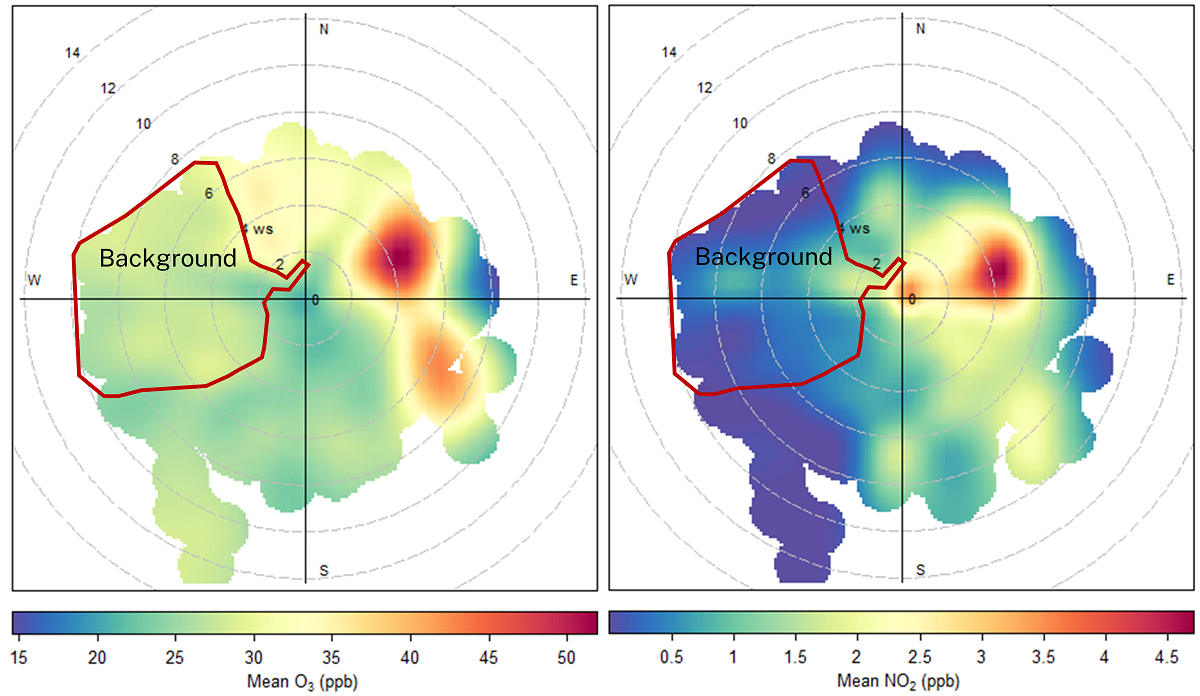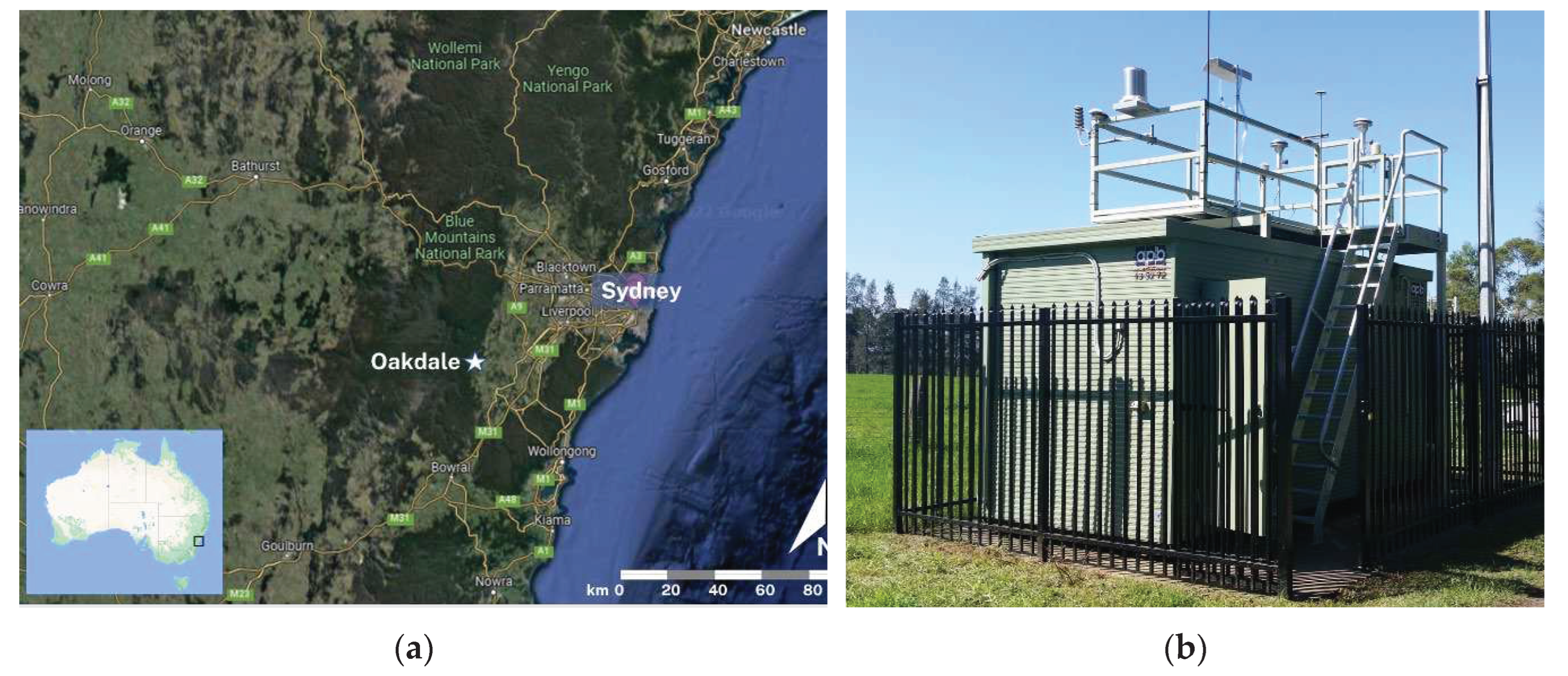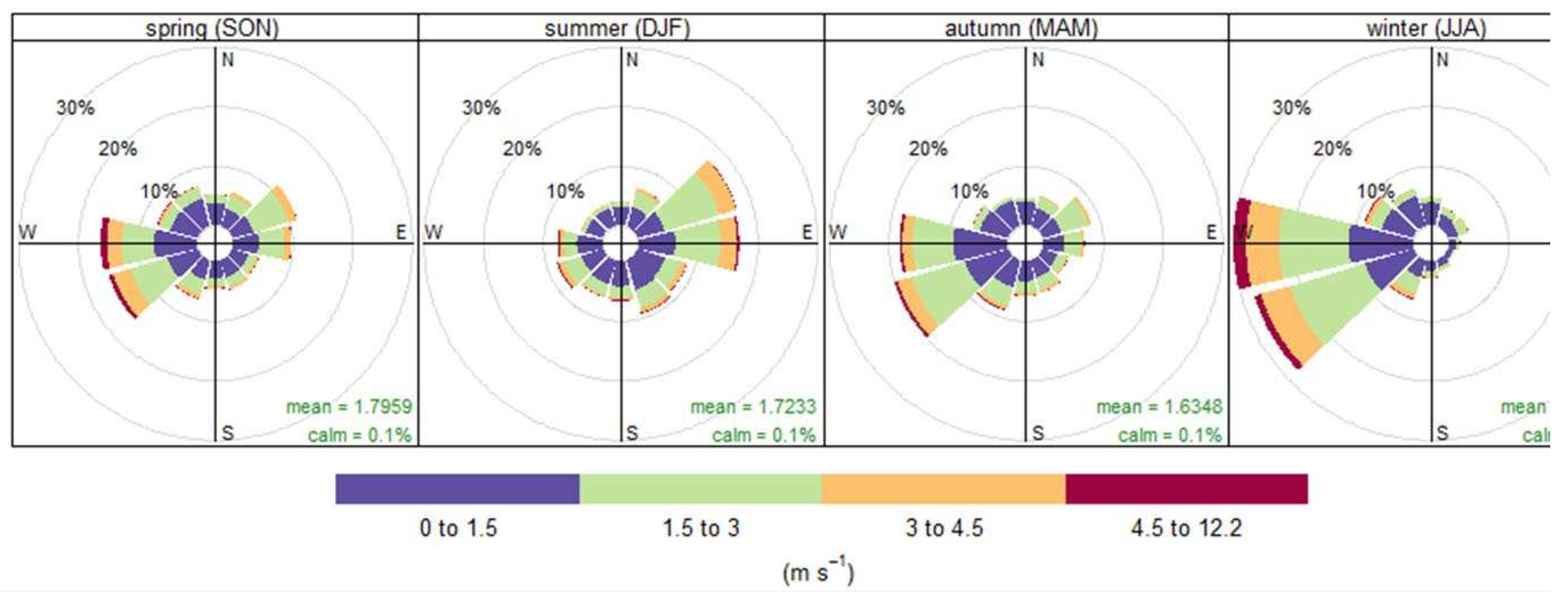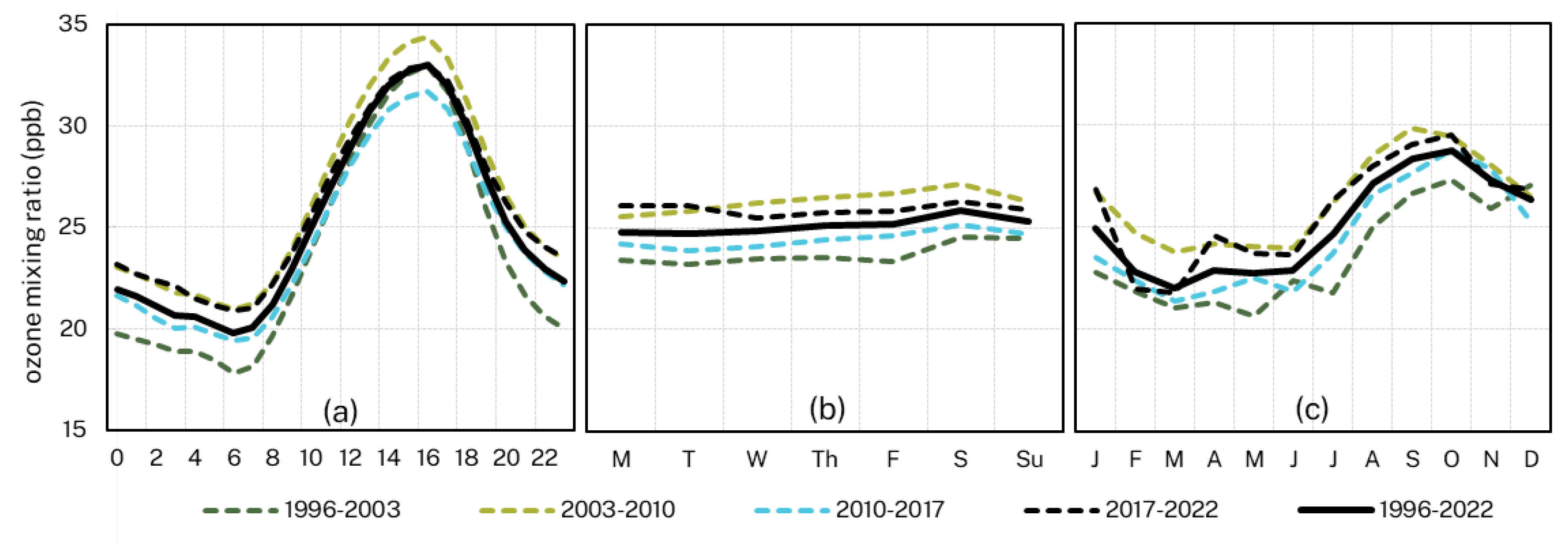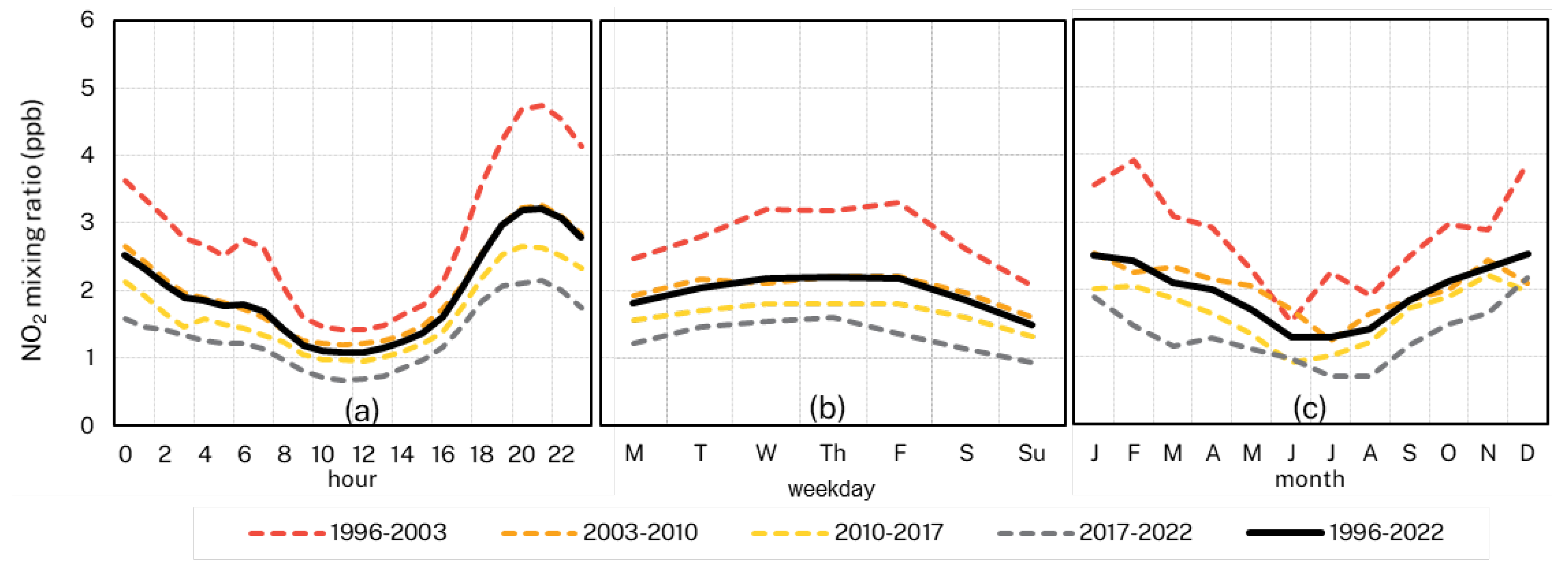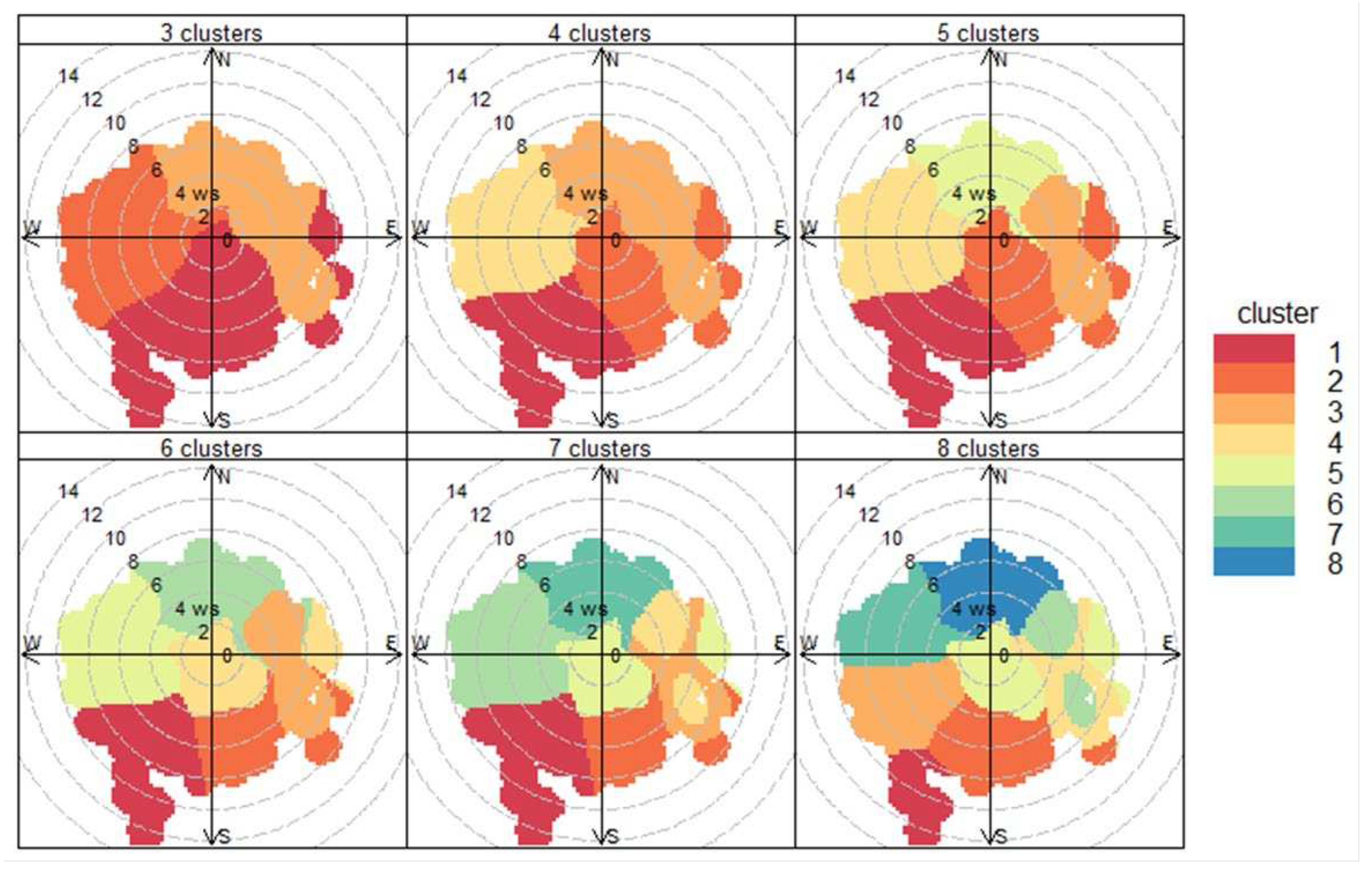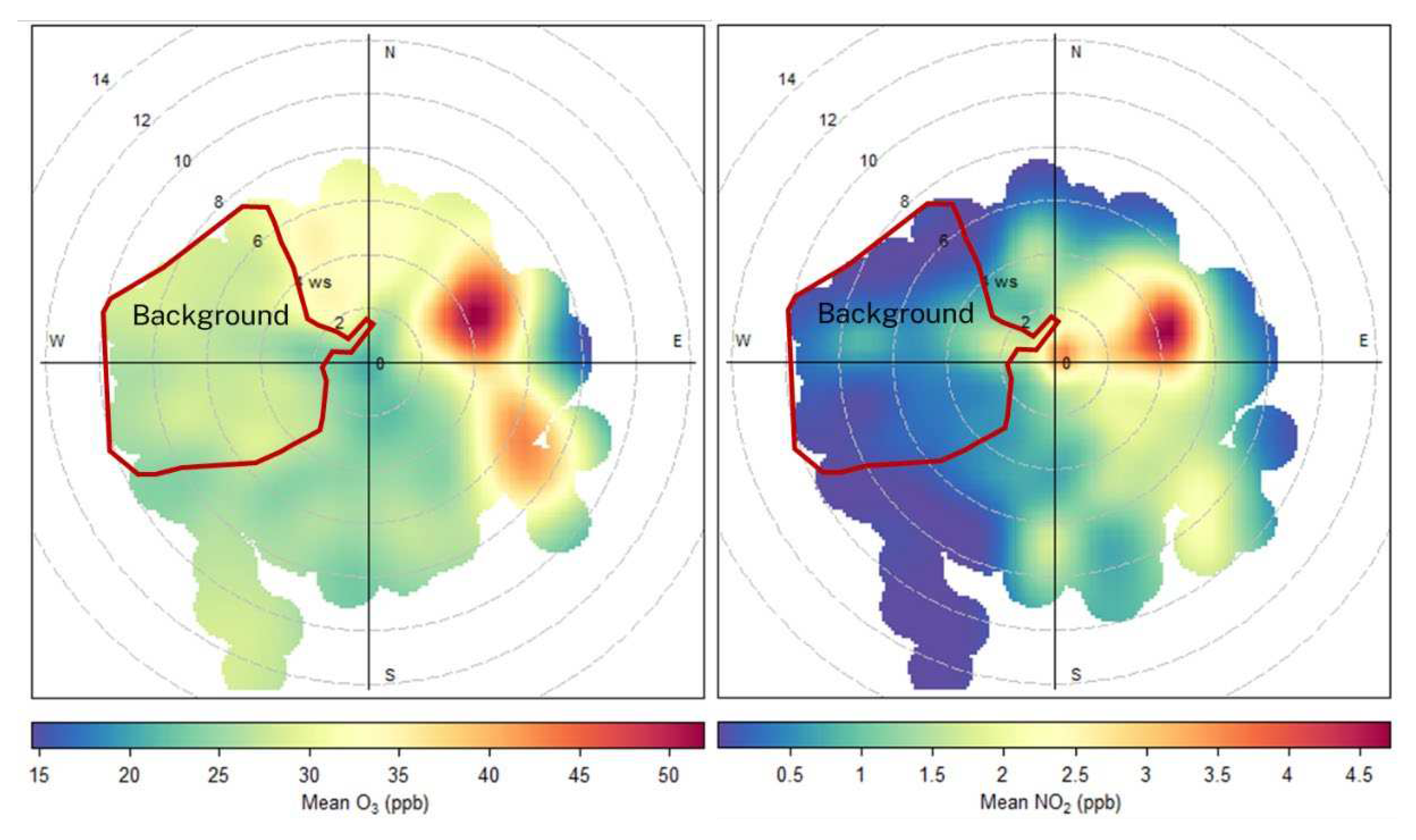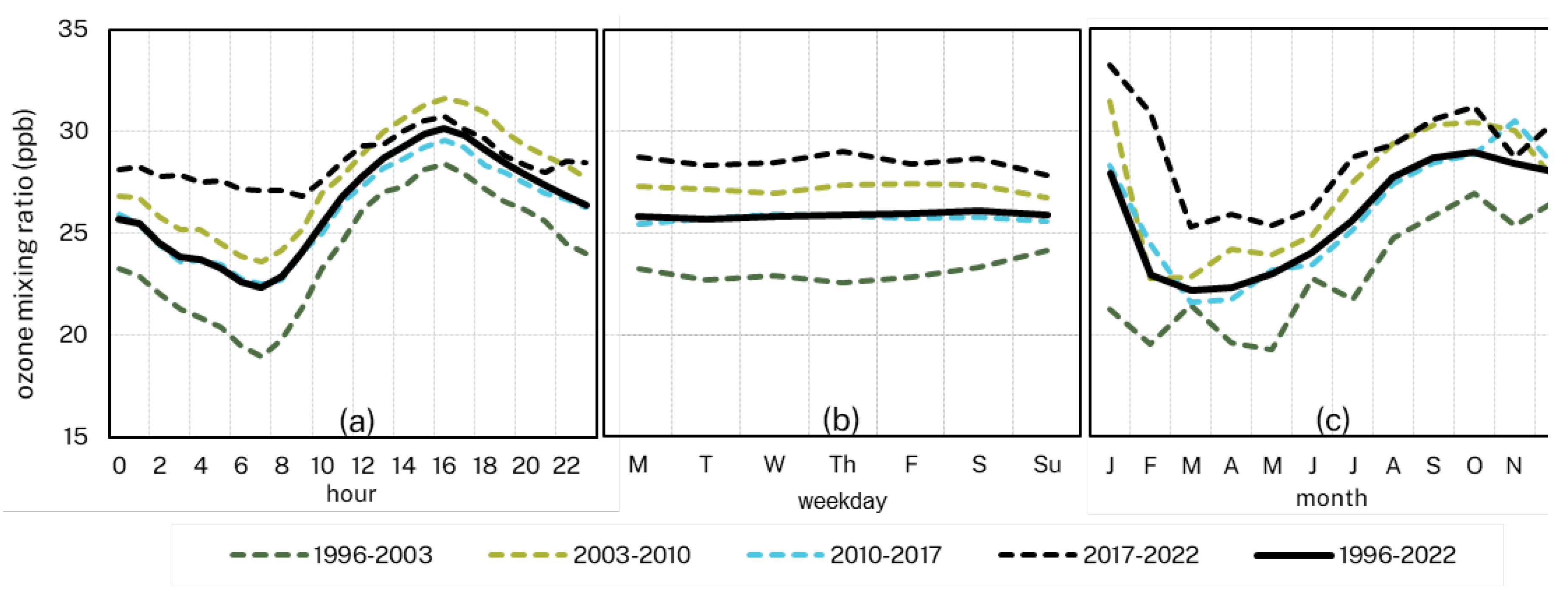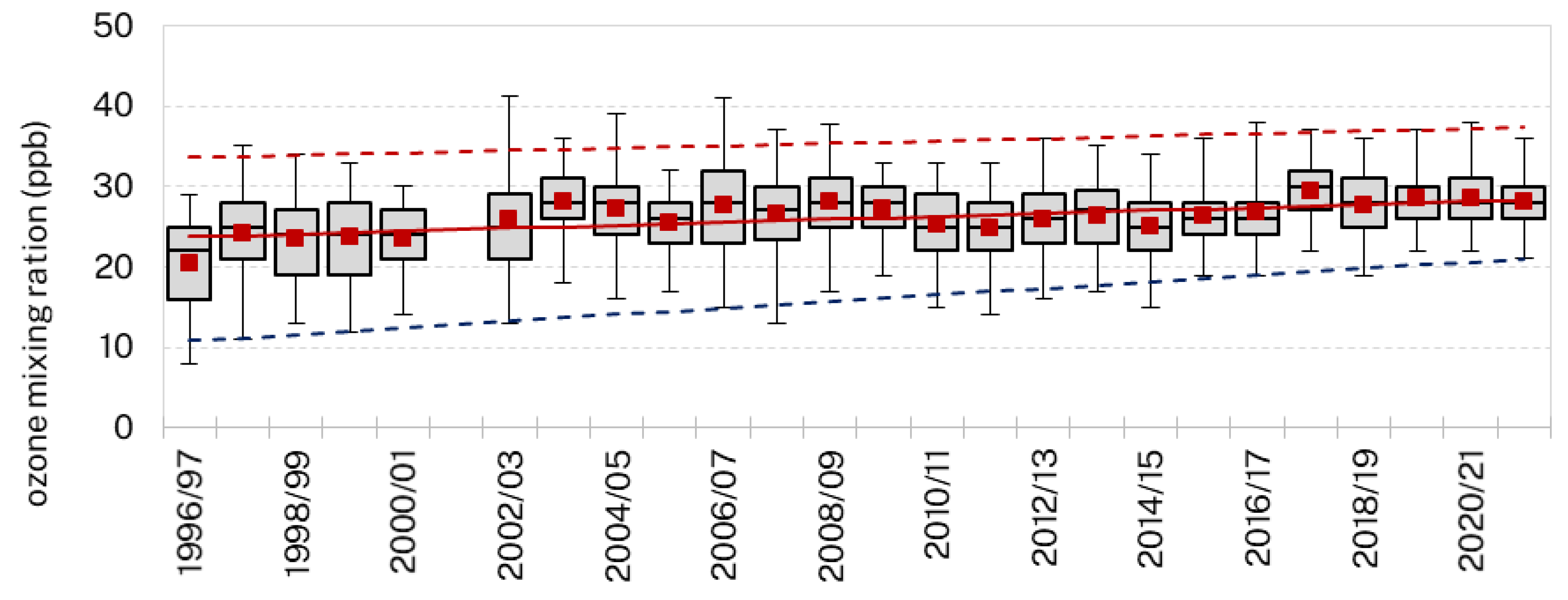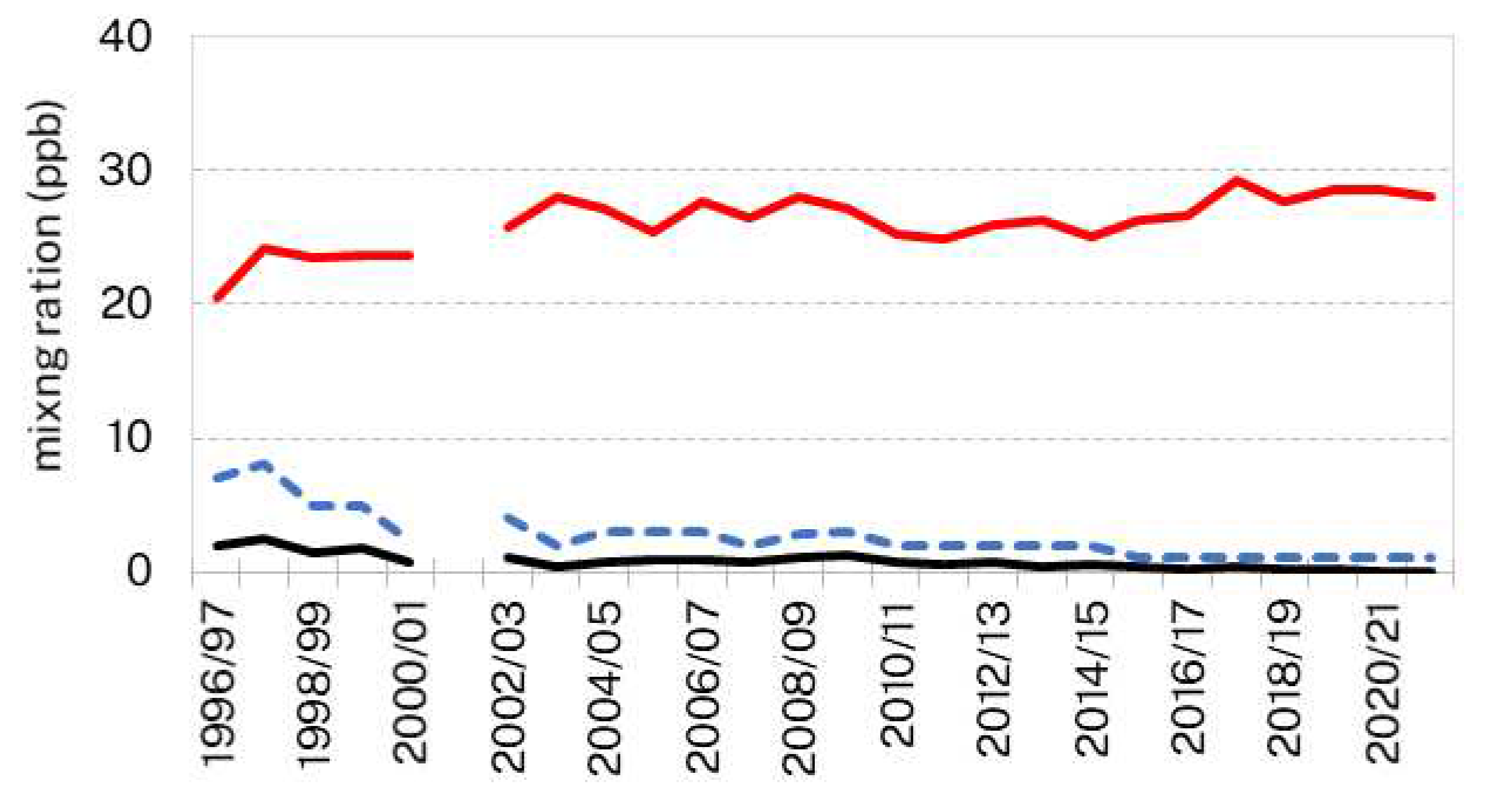1. Introduction
Ground level ozone (O
3) is an air pollutant that can impact human health, vegetation, materials, and amenity [
1,
2,
3]. It is a secondary pollutant formed by complex chemical reactions occurring between volatile organic compounds (VOCs) and reactive nitrogen (NOy) in the presence of sunlight. Ozone precursor emissions have many sources both natural and anthropogenic. Naturally occurring ozone is often termed “background ozone” (see below). Understanding background ozone is critical in assisting policy makers to understand what is achievable through emissions reduction programs and to design effective, well-targeted, policies and programs. Better understanding of background ozone also assists in the development of chemical transport models [
4].
Ozone production occurs through complex reaction chains but can be conceptualised simply as a product of reactions between hydroxyl radicals (·OH), VOCs, carbon monoxide (CO) and oxides of nitrogen (NOx = NO + O
3) in the presence of UV-radiation (hv). Ozone concentrations in a region are a function of local emissions, and aged ozone and precursor emissions transported into the region. We can define oxidant (OX = O
3 + NO
2) as a combination of local (OX
l) and regional contributions (OXr) where OX = OX
l + OX
r. OX has two identifiable contributions, NOx -independent (or regional) contribution and NOx -dependent (or local) contribution [
5].
In natural settings the production of ozone is limited by the availability of NOx, i.e., is NOx-limited [
6], however there is ample evidence that in many regions there are sufficient natural sources of NOx to produce “background” or “natural” ozone levels in the range of 20-45 ppb [
7]. This has been important in the Northern Hemisphere where inter- and intra-regional transport of air pollution impacts local pollution [
8,
9,
10,
11].
In the Northern Hemisphere, the USA Environmental Protection Agency’s (USEPA) Clean Air Act considers background ozone in standard making [
12]. The USEPA defines policy relevant background (PRB) ozone as the distribution of ozone that would occur in the continental USA in the absence of anthropogenic emissions from the USA, Canada, and Mexico [
13]. In the European Union (EU) Directive 2002/3/EC regional background ozone concentrations are determined using suburban stations upwind of the highest concentrations of ambient ozone [
14].
In contrast to the Northern Hemisphere, background ozone has been less scrutinised in Australia. This may be due to a more limited understanding of background ozone in Australia due to a perceived lack of inter-regional transport in the Southern Hemisphere and an absence of trans-boundary conflicts related to air pollution management. There is a lack of background ozone monitoring in Australia or the Southern Hemisphere [
7,
15], however inter-regional and trans-hemispherical transport of NOx is only a small contributor to ozone levels in Australia [
16]. Nevertheless, a better understanding of background ozone in Australia can assist policy makers in setting achievable ozone standards and well-targeted emissions reduction policies [
15].
The aim of this study is to develop new understanding of the trends in regional background ozone levels in Eastern Australia using data from a long-term semi-rural, performance monitoring station (Oakdale, New South Wales). This station meets the definition of a site relevant for background ozone measurements under EU Directive 2002/3/EC
1.1. Background ozone monitoring in Australia
In Australia, background concentrations of tropospheric ozone have not been extensively studied [
15]. There have been measurements in rural and regional communities including stations, in the Latrobe Valley, Victoria [
17], Ovens, Victoria and Manjimup, Western Australia [
18] and Gunnedah, NSW [
15]. Baseline marine ozone is also measured at the Cape Grim Global Atmosphere Watch (GAW) baseline station [
19].
At Cape Grim monthly average baseline ozone is between 14 – 30 ppb with maximum concentrations in winter and minimums in summer [
19]. Annual average ozone is around 25 ppb over the period 1982-2017 with no significant trend [
20]. (Note: Throughout this paper we present results as mixing ratios stated as parts per billion by volume (ppb) rather than nmol/mol).
In the Latrobe Valley, “the behaviour of ozone is explained largely in terms of natural background atmospheric processes” [
17] and 85% of high ozone days in the Latrobe Valley coincided with high pressure systems over the Tasman Sea [
21], similar to synoptic classifications for high ozone in Sydney [
22,
23]. This indicates that strong advection from the continental land mass impacts on ozone production during these conditions. From 1995-2019 the annual median of the daily maximum ozone at Traralgon has ranged between 21-29 ppb [
24].
Rural ozone levels from a two-year smoke monitoring campaign at Ovens, Victoria and Manjimup, Western Australia [
18] reported annual average ozone at Manjimup of ~19 ppb, with summer minimum and maximum concentrations in Winter/Spring. Ozone was influenced by long-range transport of smoke during spring, domestic woodsmoke in winter and from photochemical destruction of ozone in the marine boundary layer during summer. At Ovens, reported annual average ozone of 17 ppb with maximums in summer and minimum concentrations in winter. However, at Ovens ozone was influenced by local emissions due to smoke trapped under nocturnal temperature inversions in winter or bushfire smoke in summer and hazard reduction burns in autumn.
1.2. Statistically inferred background ozone in NSW
In the absence of direct measurements at suitable background locations, several approaches have been proposed to assess possible background signals within non-background monitoring data. A study of non-photochemical night-time background ozone [
25] inferred background ozone at sites in the Sydney region. They found that background ozone in Sydney was between 16-21 ppb and noted an increasing trend for the period analysed.
More recently, [
15] used k-means clustering to infer background ozone levels for the 2018-2020 at a newly installed rural station, Gunnedah, NSW. They found that background ozone mixing ratios were 36-39 ppb for airmasses of continental origin, i.e., when the ambient air likely had little impact from local emissions sources. This study further demonstrates the utility of this approach by applying the techniques to a long-term ozone monitoring dataset from Oakdale, Sydney. We summarise key ozone metrics (mean, max, quantiles, etc) and assess for any trends within this cluster over the period 1996-2022 (details in
Section 2). The study advocates that long-term monitoring stations within or near urban areas can provide suitable conditions and datasets for regional Global Atmosphere Watch monitoring (
Section 3).
2. Data and Methods
2.1. Measurement site and regional context
Oakdale (pop. 2028) is a small rural community on the western outskirts of Sydney, approx. 65 km southwest of the central business district. The station (34° 3' 6"S, 150° 29' 53"E) is situated on farmland on the western edge of the Sydney Basin at an altitude of 457 metres (
Figure 1). The station was established in 1996 to assess transport of ozone from the basin under the regional sea breeze circulation, firstly as a campaign station before transitioning to a permanent station in 2003. It is now a core component of the NSW Government’s Air Quality Monitoring Network (AQMN) and monitoring plan.
West of the station is the world-heritage listed Greater Blue Mountains region (10300 km²), including the Blue Mountains, Nattai, and Kanangra-Boyd National Parks. Emissions from this sector (Blue Mountains, Oberon, Upper Lachlan areas) are totally dominated by natural emissions (92% or 17.8 kt p.a. VOC and 75% or 2.7 kt p.a. NOx) (
https://www.epa.nsw.gov.au/your-environment/air/air-emissions-inventory).
There are coal-fired power stations WNW of the station. Mt Piper power station is a 1400 MW station with two boilers. It is approx. 88 km WNW of Oakdale. Wallerawang power station was a 1000 MW station with two units located approx. 82 km WNW of Oakdale. Wallerawang operated from 1957 until April 2014. Both stations have operated with low-NOx burners since 1993. In 2013 these stations together emitted 38.0 kt NOx while in 2021 Mt Piper emitted 18.0 kt. (
https://www.dcceew.gov.au/environment/protection/npi).
East of the station is the Sydney Basin with a population of 5.2 million people. Sydney’s basin topography and coastal setting can trap air pollution under certain synoptic - local meteorological configurations. Katabatic flow drains from the Blue Mountains towards the coast accumulating emissions. Sea breezes can then transport this contaminated air mass back over urban areas where fresh emissions are added. This local land-sea circulation may persist for several days at times, especially when coincident with certain synoptic conditions such as a high-pressure system centred in the Tasman Sea [
22,
23].
The predominant wind in Oakdale is westerly or south-westerly in all seasons except summer (
Figure 2). In summer, the regional sea breeze circulation predominates, transporting pollutants from the eastern part of the basin to Oakdale.
The estimated population within 25km of the station is approximately 100,000 people (>99% of those to the eastern sector), within 10km the population is ~6,000. The TOAR database (Schultz et. al. 2017,
https://join.fz-juelich.de) assesses nearby (25 km radius) land use categories as: evergreen broadleaf forest 64.7 %, woody savannas 17.6 %, grasslands 6.4 %, croplands: 5.1 %, cropland/natural vegetation mosaic 2.3 %, water 1.2 %, and urban and built-up 1.0 %.
2.2 Instrumentation, calibration, and maintenance
Monitoring at Oakdale commenced in April 1996, with continuous data collection for ozone, oxides of nitrogen (NO, NO
2, NOx), particles (PM10 – TEOM, nephelometer), and meteorology (temperature, relative humidity, wind). Ozone is measured by ultraviolet (254nm) photometry (TEI 49C, EC9810, API T400). NOx is measured by chemiluminescence with molybdenum converter (TEI 42C, EC9841, API T200). Instrument sets have been swapped at times (
Table 1), with instrument exchanges occurring after prolonged inter-comparison studies at other sites showed no statistically significant difference between instrument types.
The glass manifold sampling inlet is at 3m height and draws sample air continuously via a blower pump. Sample is then drawn from the manifold by individual instruments using their internal pumps (flow rate 0.5 lpm) through 0.635 mm Teflon/PTFE tubing. This sample tubing is ~0.5 m in length, resulting in a residence time within the PTFE sample line of ~2 s. On the tubing inline particle filters (47mm, 5 μm) remove particles prior to entering the instrument, and a second particle filter within each instrument removes any residual particles (i.e., double filtering).
Ozone calibrations are carried out in compliance with Australia Standard AS/NZS 3580.6.1 and are consistent with the WMO Guidelines for Continuous Measurements of Ozone in the Troposphere (
https://library.wmo.int/doc_num.php?explnum_id=7814). Initial calibrations occur on instrument commissioning and after all major maintenance activities and include checks of zero and 4 points (50, 100, 200, 400 ppb). Multi-point audits and calibrations occur every 6-months using the same check points as the initial calibration.
Zero and single-point checks occur daily at 01:00 AEST. For the NOx instrument, NIST traceable gas (NO) in a multi-component mix is diluted with zero air and provided at known concentration. Ozone is generated on site at a specific concentration and after a short period of NO measurement is introduced to the NOx instrument, forming NO
2 at a known concentration and assessing instrument gas-phase-titration and converter efficiency. The generated ozone is simultaneously introduced to the ozone instrument. Ozone measurements and generation are traceable to Standard Reference Photometer (SRP-21) [
26] through transfer standards (Dasibi 1008, Tanabyte T724).
Routine maintenance is carried out on all instruments in compliance with relevant Australia Standards (AS/NZS 3580.1.1 – Station Siting, AS/NZS 3580.5.1 – NOx, AS/NZS 3580.6.1 – Ozone, AS/NZS 3580.14 – Meteorology). This includes monthly inspection cleaning of the sample system, replacement of external inline particle filters, and leak checks; six monthly – replacement of internal particle filters, sample line cleaning, UV lamp and scrubber efficiency tests; and annually – clean reaction cells, replace scrubbers, service sample pumps.
2.3. Data handling
Data validation complies with AS/NZS 3580.19. Data is included in our analysis when it met the 75% data availability criteria set for demonstrating NEPM (expand if first appearing) compliance [
27]. That is, a valid hourly average is provided when at least 75% of 1-minute average data are valid and valid 8-hourly averages are calculated when at least 75% of hourly values in the period are valid. A daily summary is reported when 75% of hourly samples in the day are valid; a yearly summary is provided when 75% of days in the year are valid and each calendar quarter has 75% valid days. We extend this acceptance test to include valid seasons where 75% of days in the season are valid (austral seasons: summer (Dec-Feb), autumn (Mar-May), winter (Jun-Aug), spring (Sep-Nov)).
The daily span and zero tests for the ozone and NOx instruments result in lost hours. Gaps due to these tests are typically 1-hour but may be 2-hours long prior to 1999 due to a longer time allocated for the zero/span check initially. These gaps are filled through linear interpolation when both hours either side of the missing value are present and valid. If either value is missing the data are not interpolated.
Data capture rates are typically high, however there have been some extended periods of missing ozone data due to various reasons (
Figure 3). Of most note is data excluded from April 2001 – October 2002 due to issues with power supply and questionable performance of the monitor due to potential issues with sample tubing.
Overall valid hourly ozone measurements were recorded for 94% of the period (24,637 valid hours). This delivered summary datasets with 8315 (89%) valid days, 264 valid months (85%) and 83 valid seasons (80%).
VOCs at high concentrations can interfere with ozone measured using UV photometry [
28]. All ozone instruments used at Oakdale have operated with solid manganese dioxide catalytic scrubbers, hence our measurements are susceptible to interferences from VOCs at high concentrations. There are very few anthropogenic sources of VOCs in the vicinity, however within smoke plumes VOC levels can be large and may impact on the ozone measurements. To minimise these impacts on our analysis we exclude periods impacted by smoke events from bushfires or hazard reduction burning. We do this by excluding data from the analysis where coincident nephelometer measurements are high (bsp > 2.1 Mm-1), a strong marker of bushfire/hazard reduction burning smoke.
Commercial NOx monitors such as those we use at Oakdale, can see interferences from other reactive nitrogen species such as nitrous acid (HONO), nitric acid (HNO
3), nitric acid anhydride (N
2O
5), alkyl nitrates (RONO
2), peroxyacetyl nitrates (PAN), ammonia (NH
3) and nitrate aerosols [
29]. The NOx we report here is more accurately NOy = NO + NO
2 + NOz, where NOz = HONO + HNO
3 + N
2O
5 + RONO
2 + PAN + other N species.
2.4. Identifying background ozone
Background ozone has many definitions: policy relevant (US EPA), baseline [
30], night-time [
25], daytime [
31] and warm-season [
32]. An extensive overview of the different terms and approaches to calculating background is found in [
30].
In this study we interpret background ozone similarly to [
33] who use principal component analysis to identify and assess baseline ozone in North America across 97 non-urban sites. Recently [
15] applied k-means clustering (analogous to principal component analysis from [
33]) to identify background ozone at Gunnedah, Australia.
The k-means algorithm is an iterative clustering process that groups together data with similar characteristics, here ozone and meteorology. Initially, k points are randomly chosen from the observation set. These points act as centroids for each k cluster. Observations are then assigned to the group of the closest centroid (based on standardised Euclidean distance). Once all observations have been assigned to a group, new k centroids are chosen and the the process repeated until convergence, i.e., the centroids do not move and the standardised Euclidean distance within the groups is minimised. We implement the algorithm within the openair R package [
34,
35].
The method helps identify clusters where the influence of local emissions is minimised, and background ozone contributions are maximised. Here we use the term “background ozone” to refer to regional background, that is ozone levels that are typically representative of a broad region and that are little influenced by anthropogenic emissions within the region.
2.5. Trend identification and quantification
The standard nonparametric Mann-Kendall (M-K) test for trend is appropriate and well-suited to test the presence of trend in the air quality summary statistics data. It is simple, robust, does not require prior knowledge of the ozone distribution and has been used extensively in the air quality literature. M-K tests whether data series with time (x versus t) tend to increase or decrease (i.e., monotonic change) [
36].
If a statistically significant trend was found the slope of the trend was estimated using Sen’s non-parametric method [
36].
3. Results
We commence by describing the full ozone record at the site, including analysis of seasonal, weekday and diurnal variations. To assist in interpretation, we break the data into four periods: 1996/97-2002/03, 2002/03-2010/11, 2010/11-2017/18, 2017/18-2021/22, noting that the first period covers five years of data only due to missing data. Seven-year periods are selected to approximate the long-term frequency of central pacific El-Nino events found by [
37], i.e., approximately 4 events per 30 years. We note however that while this choice is based in the physical climate and is supported through previous work on synoptic classification in eastern Australia [
23,
38], our temporal sub-setting is somewhat arbitrary, as the main goal is simply to assist in analysis and investigation of the results.
We also assess for trends in the full ozone, NO2, and OX datasets to assess overall photochemical characteristics at the site. Trend analysis includes annual averages, daily maxima, and quantiles (median, 25th, 75th and 95th percentiles).
3.1. Annual, seasonal, day-of-week and diurnal variations
Over the entire observation set, mean ozone mixing ratio was 25.2 ppb. Annual (Jul-Jun) mean anomalies, that is, the variation of the annual mean from the mean of the full observational period (1996-2022), vary from -4.0 ppb in 1996/97 through to +3.4 ppb in 2006/07. Anomalies broadly coincide with the El Niño-Southern Oscillation, with typically below average concentrations during La Niña years and higher than average during El Niño events as classified by the Oceanic Niño Index (
Figure 4).
Diurnal ozone profiles were similar across all periods but with some variation. Peak ozone is typically observed between 1200-1800 with mean concentrations of 31.3 ppb and minimum concentrations mid-morning 0000-0800 (20.8 ppb). Lower night-time concentrations were observed during 1996-2003 (18.9 ppb) while daytime concentrations in that period were comparable to recent years. Higher daytime peak concentrations were seen during 2003-2010 (32.7 ppb) (
Table 2).
There is little variation in ozone concentrations throughout the week, however there is some indication of a weekend effect, particularly in the early years of the record (
Figure 5b). We observe 1996-2003 showing statistically significant weekend effect (based on overlap of the 95% confidence intervals in the mean). Over the entire period mean weekday ozone concentrations were 25.0 ppb with mean weekend concentration of 25.6 ppb.
Seasonal variations show higher ozone concentrations from Aug-Dec (mean 27.6 ppb). A springtime peak is evident in Sep-Oct (28.6 ppb) across all periods. The mean difference between the springtime peak and the autumn minima (MAM) was 5.6 ppb and ranged from 5.1 ppb (2003–2010) to 6.2 ppb (2010–2017).
As expected from the emissions profiles of the surrounding region, observed NO
2 concentrations are typically very low. Across all available data, mean NO
2 concentrations are 2.0 ppb. Further, analysis of the diurnal and weekday NO
2 profiles (
Figure 6) show only small variations in monthly concentrations with maxima in Dec-Jan (2.5 ppb) and minima in Jun-Aug (1.3 ppb). There is little weekday/weekend variation in NO
2 with weekday mean concentrations (2.1 ppb) slightly higher than weekends (1.7 ppb). Diurnal profiles show a peak in the evening. Together with slightly higher concentrations in summer and during the week, this implies that the evening peak may be due to transport of air from the Sydney basing during sea breeze events.
NO2 concentrations are notably higher in the 1996-2003 period (Table x). This may be due to the higher NOx emissions in the Sydney basin prior to the banning of leaded petrol and the introduction of US’90 (1999) and EURO 2 (2004) vehicle emissions standards. NO2 concentrations continue to fall as motor vehicle NOx emissions decline.
3.2. Identifying a background cluster
The EU Directive supports the assessment of background ozone in the vicinity of an urban conglomeration if it is sited upwind of the urban area. The complex topography of the Sydney basin and its coastal location means that identifying stations that are purely upwind of the city is difficult due to synoptic and mesoscale processes within the region. For example, at Oakdale regional westerly to south-westerly flows dominate in winter leading to a clear designation as an upwind site. In contrast, during summer the sea-breeze/land-breeze circulation means that Oakdale is both upwind and downwind of the city depending on the predominant synoptic conditions and the time of day.
We apply k-means clustering to categorise ozone at Oakdale into several clusters. This is comparable to clustering of back trajectories but using local wind speed, wind direction and concentrations to group similar conditions rather than air mass origins [
39]. We substitute k-means clusters for the principal components used by [
33] and test clustering with 3 ≤ k ≤ 8 (
Figure 7). We identify a cluster of ozone in the sector of ~235° – 325° with wind speeds >~2 ms-1 and associated with low NO
2 (
Figure 8). Many of the observations in this cluster are commonly assigned to the same cluster regardless of the values of k. We therefore assess that a likely optimal clustering for classifying background ozone occurs at Oakdale with k = 4.
Table 3 summarises mean ozone and NO
2 mixing ratios for each cluster (k=4). Mean O
3 for all hours in the background cluster (Cluster 4) is 25.9 ppb. Warm season (Oct-Mar) mean background O
3 is 27.2 ppb and mean NO
2 is 1.3 ppb.
The clustering also identifies a cluster (no. 3) that has considerably higher O
3 and lower NO
2 than the background cluster. Average warm season (2.6 ppb) and annual (2.5 ppb) NO
2 is higher than the background cluster (1.3 and 0.9 ppb respectively) while warm season (35.9 ppb) and annual (34.5 ppb) O
3 is also greater than background. Cluster 3 represents transport of air masses from the Sydney basin, particularly in the warm season under NNE sea breeze events. There is some variation within the background cluster through the period (
Table 4). There is a lower number of observations in the background cluster for 2017-2022 due to fewer years and screening out of significant amounts of data due to bushfires (Sep 2019 – Feb 2020) and hazard reductions burns.
Within the background cluster there is little variation in ozone concentrations throughout the week. Diurnal variations are evident, but their amplitude is lower compared to the entire observational dataset. The seasonal signal of the background cluster is like the overall dataset, with ozone maxima in Sep-Oct and minima in Mar-May (
Figure 9).
3.3 Trends in background ozone
Following the identification of a cluster of measurements likely representative of background air masses, we test for any trends and their significance. Firstly, we summarize the annual (Jul-Jun) hourly ozone measurements within the background cluster.
Figure 10 shows the distribution of hourly measured background ozone. Here we plot the interquartile range (box), the median (dash within the box), mean (red square), and represent the 5th and 95th percentiles as the upper and lower whiskers. The lines show significant trends in the 5th and 95th percentiles and the annual mean.
We apply the M-K test for monotonic change on the annual statistics for the background ozone distribution. If a significant trend (at α=0.05) is identified, we use the Sen estimator to quantify that trend.
Table 5 summarises the trend analysis. We find significant increasing trends in the 5th, 25th, 50th (median) and 75th percentiles, the annual mean, and the annual standard deviation of background ozone. We also find that the trend in the 95th percentile is significant if we set α=0.1. There is no significant trend in the annual maximum 1-hour background ozone at the 0.1 significance level.
The distribution of background ozone is narrowing, with the standard deviation of hourly ozone declining by 0.8 (0.4 – 1.2) ppb per decade. Much of this trend is seen through greater increases in the lower end of the distribution rather than in peak ozone concentrations. The 5th percentile is increasing at 4.1 (2.9 – 5.3) ppb per decade and the 25th percentile at 2.5 (1.4 – 3.6) ppb per decade, while the 95th percentile is increasing at 1.5 (0.0 – 3.1) ppb/decade and there is no significant trend in annual maximums. Mean annual background ozone at Oakdale is increasing by 1.8 (1.0 – 2.8) ppb/decade.
Even though NOx emissions from the background sector are low, they are non-trivial particularly in the early years of the record. Assessment of the annual distribution of NO
2 mixing ratios identifies several aspects that can help explain some of the observed increases in background ozone. The M-K test identifies significant reductions in annual maximum, mean, median, standard deviation and the 95th and 75th percentiles. No trend was found in the 5th and 25th percentiles as these are near zero throughout the record. Annual mean background NO
2 mixing ratios are declining by 0.6 (0.5 – 0.7) ppb/decade. Annual 1-hour maxima have declined by 5.8 (4.4 – 8.2) ppb per decade while the 95th percentile of observations is declining by 1.7 (1.3 – 2.1) ppb/decade (
Figure 11). These significant declines in the higher NO
2 mixing ratios within the background air may signify that earlier in the record emissions from the distant power stations may be identifiable within the background cluster.
We hypothesize that some of the increases in background ozone are likely due to reduced NOx emissions from the distant power stations and more broadly from lower motor vehicle emissions in the wider region. As NOx emissions from these sources reduce, the effects of NO titration on regional background ozone diminishes. From 2004 onwards, mean NO2 mixing ratios in background air have been <1.2 ppb and the 95th percentile of hourly NO2 measurements have been <3.0 ppb and from 2014 (the Wallerawang station’s closure) mean NO2 is 0.3 ppb and the 95th percentile is 1.1 ppb. Hence, while there still may be some contribution from the power station sources, this contribution is diminishing.
4. Discussion
The GAW mission statement [
40] highlights the multiple benefits that a better understanding of background tropospheric ozone can provide. For example, robust estimates of regional background ozone supports policy makers to understand the limits to reducing ozone by controlling anthropogenic emissions alone. The GAW reactive gases network [
41] acknowledges that “long-term observations of reactive gases in the troposphere are important for understanding trace gas cycles and the oxidation capacity of the atmosphere, assessing impacts of emission changes, verifying numerical model simulations, and quantifying the interactions between short-lived compounds and climate change”.
The GAW global and regional networks provide critical information on global and regional tropospheric ozone. However, within Australia the only long-term monitoring for GAW reactive gases is from Cape Grim, a baseline station focussed on the Southern Ocean marine environment. There are no GAW stations in Australia that focus on regional background reactive gases of continental origin. Most Australian jurisdictions have focussed on ozone measurements in city/urban environments, limiting our understanding of Australian regional background ozone.
Consequently, there is a lack of evidence to support robust estimates of Australian background ozone. This impacts on a range of outcomes. For example, it
limits the ability of epidemiologists to assess the impacts of anthropogenic ozone on communities,
limits the ability of ecologists and agronomists to robustly estimate the impacts of ozone on natural ecosystems, vegetation and crops,
hampers further understanding of the background atmospheric environment within Australian, and
constrains the improvement of chemical transport models within the Australian context.
The GAW Reactive Gases Scientific Advisory Group (SAG) has acknowledged this lack of background ozone measurements in the southern hemisphere. SAG activities [
40] aim to promote/facilitate the expansion of reactive gases observations in under-sampled regions, e.g., the Southern hemisphere, and to improve integration of observations of reactive gases from national and regional air quality monitoring networks and GAW stations on all spatial scales.
In this study, we have attempted to use the unique siting and regional characteristics of the Oakdale station to identify background air parcels and then estimate the concentrations of key reactive gases ozone and NO2. Oakdale is a long-term station that is well-sited and is operated under a rigorous, documented and audited, quality assurance program. Ozone measurements from Oakdale are directly traceable to SRP21 and NO/NO2 measurements to SRP21 and NIST certified standards. We have used these characteristics and statistical methods to identify a background sector for Oakdale that would likely adhere to GAW requirements for a regional station.
More formally assessing GAW requirements for regional stations [
42], Oakdale meets the following:
- 5.
it is regionally representative and is normally free of the influence of significant local pollution sources or at least frequently experiences advection of pollution-free air from specific wind directions. We use k-means clustering to identify a regional background signal that occurs 24% of the time. Within this cluster we show that NO titration from local emissions is low (mean NO2 <1.2 ppb and since 2014 mean NO2 ≤0.3 ppb.)
- 6.
a commitment by the responsible agency to long-term observations of at least two variables in at least one GAW focal areas. Oakdale has operated since 1996 and is a core component of the NSW AQMN and its ongoing plan. Oakdale monitors reactive gases (O3, NOx), aerosols (PM2.5 mass, PM10 mass, light scattering) and UV radiation.
- 7.
greater than 90% data capture. Since 2002 data recovery rates are >96%.
- 8.
Standard meteorological in situ observations. Temperature, relative humidity, horizontal wind, and pressure are measured at the station.
Additionally, the GAW QA requirements (requirements 5 – 7, not shown) are also met, and the network that Oakdale is part of is independently accredited by the National Association of Testing Authorities. Currently data from Oakdale are available through TOAR database [
20] (
https://toar-data.org/) and the NSW air quality data services (
https://www.dpie.nsw.gov.au/air-quality/air-quality-data-services). Data are not submitted to a GAW World Data Centre or GAWSIS, but this is under consideration.
Trend analysis on ozone within the Oakdale background cluster identified statistically significant trends. The distribution of background ozone is narrowing, driven by greater increases in the lower end of the distribution rather than in peak ozone concentrations. The 5th, 25th and 95th percentiles are all increasing but at differing rates (4.1, 2.5, 1.5 ppb/decade respectively). Mean annual background ozone at Oakdale is increasing by 1.8 (1.0 – 2.8) ppb/decade.
Using TOAR data [
43], find that in the southern hemisphere, there is little evidence for an increase of ozone from the historical to the modern period. Focussing on recent trends at baseline southern hemisphere sites, significant trends in ozone at Cape Grim (0.6 ppb/decade, 1982-2010), Cape Point (1.9 ppb/decade, 1983-2011) and Arrival Heights (2.9 ppb/decade, 1997-2008) were found [
44]. However, there are only nine southern hemisphere sites included in their analysis.
The night-time background ozone trend reported in Western Sydney of 4.3 ppb/decade based on data from 1998-2005 [
25], is significantly higher than our assessment of 1.8 ppb/decade for background air at Oakdale. This is the only analysis that we are aware of that attempts to quantify background ozone in Australia besides the Cape Grim measurements, highlighting the need for further monitoring and analysis of Australian background ozone.
5. Conclusions
Extending the work of [
15], we use k-means clustering on a long-term dataset from Oakdale, NSW to identify a measurement cluster that likely represents background air in eastern Australia of continental origin. The cluster is characterised by winds from the SW-NW sector, with wind speeds >2 ms-1 and associated low NO
2. Early in the record we observe higher peak NO
2 measurements within the cluster and attribute this to some transport of emissions from distant power stations (~82 km to the NNW). Emissions from these power stations declined significantly from 2014 and now mean NO
2 concentrations in the background cluster are ~0.2 ppb, indicating little impact of local NOx emissions.
Focusing on the most recent period (2017–2022) we find annual mean background ozone of 28.5 ppb. We find a statistically significant (α=0.05) trend in the mean of +1.8 (1.0 – 2.8) ppb/decade. Within the background cluster there is no attributable weekday/weekend effect. There is some variation in the diurnal signal (amplitude of 4 ppb) and some seasonality with minima observed in the Austral autumn (Mar-May).
These estimates are near or slightly higher than other published results from rural or background monitoring in Australia (e.g., Gape Grim 25 ppb, Latrobe Valley 21–29 ppb, Manjimup 19 ppb, Ovens 17 ppb) but lower than recent observations from Gunnedah (36–39 ppb). Our results do not support previous conclusions on background ozone in Australia of 45 ppb [
45]. Further investigation of the representativeness of our results for Australian continental air masses is required. We intend to apply our method to other suitable long-term ozone monitoring stations in Australia (e.g., Mutdapilly QLD, Rolling Green WA).
Recently the Merriwa air quality monitoring station has been expanded to provide O
3, NO, NO
2, SO
2, CO, black carbon, PM2.5/PM10, light-scattering, AOD and mixed layer height measurements from a relatively more remote location [
46]. The data from this station, and ongoing monitoring at Gunnedah, and regional centres in NSW (Albury, Wagga Wagga, Tamworth) will be used to further assess continental background and regional ozone levels in NSW where appropriate. These data will assist to refine and further validate the method that we have applied for background ozone identification here.
Author Contributions
Conceptualization: MLR, NJ; Methodology: MLR, NJ; Formal analysis: MLR; Resources: MLR, NJ; Data Curation: MLR; Writing - Original Draft: MLR, NJ, HD, MA; Writing - Review & Editing: MLR, NJ, HD, MA; Funding acquisition: MLR.
Funding
This research received no external funding.
Data Availability Statement
Acknowledgments
We acknowledge the work of DPE technicians in maintaining the Oakdale monitoring station, including B. White, D. Hill, L. Jenson, J. Kirkwood, G. Ross, S. Serdar and many others over the years. The Oakdale station is on the traditional lands of the Dharug nation, and we acknowledge their elders, past, present, and emerging.
Conflicts of Interest
The authors declare that they have no known competing financial interests or personal relationships that could have appeared to influence the work reported in this paper.
References
- Nicolas, M., Ramalho, O. and Maupetit, F., Reactions between ozone and building products: Impact on primary and secondary emissions. Atmos. Env., 2007, 41(15), 3129-3138. [CrossRef]
- Manisalidis, I., Stavropoulou, E., Stavropoulos, A. and Bezirtzoglou, E., Environmental and health impacts of air pollution: a review. Fron. Pub. Hlth., 2020, 8, 14. [CrossRef]
- Stevens, C.J., Bell, J.N.B., Brimblecombe, P., Clark, C.M., Dise, N.B., Fowler, D., Lovett, G.M. and Wolseley, P.A., The impact of air pollution on terrestrial managed and natural vegetation. Phil. Trans. R. Soc. A, 2020, 378(2183), 20190317. [CrossRef]
- Jaffe, D.A. and Wigder, N.L., Ozone production from wildfires: A critical review. Atmos. Env., 2012, 51, 1-10. [CrossRef]
- Clapp, L.J. and Jenkin, M.E., Analysis of the Relationship between Ambient Levels of O3, NO2 and NO as a Function of NOx in the UK. Atmos. Env., 2001, 35, 6391-6405. [CrossRef]
- Fishman, J., Solomon, S. and Crutzen, P.J., Observational and theoretical evidence in support of a significant in-situ photochemical source of tropospheric ozone. Tellus, 1979, 31(5), 432-446.
- Vingarzan, R., A review of surface ozone background levels and trends. Atmos. Env. 2004, 38(21), 3431-3442.
- Vecchi, R. and Valli, G., Assessment of ozone levels at alpine sites in Northern Italy. WIT Trans. Ecol. Env., 1970, 28. 10pp.
- Cox, R.A., Eggleton, A.E.J., Derwent, R.G., Lovelock, J.E. and Pack, D.H., Long-range transport of photochemical ozone in north-western Europe. Nature, 1975, 255(5504), 118-121. [CrossRef]
- Chatfield, R. and Harrison, H., Tropospheric ozone: 1. Evidence for higher background values. J. Geo. Res., 1977, 82(37), 5965-5968. [CrossRef]
- Fishman, J. and Crutzen, P.J., The origin of ozone in the troposphere. Nature, 1978, 274(5674), pp.855-858. [CrossRef]
- Cooper, O.R., Langford, A.O., Parrish, D.D. and Fahey, D.W., Challenges of a lowered US ozone standard. Science, 2015, 348(6239), 1096-1097. [CrossRef]
- U.S. EPA. Air Quality Criteria for Ozone and Other Photochemical Oxidants, EPA 600/R-05/004aF; U.S. Environmental Protection Agency, Office of Air Quality Planning and Standards, 2006a; Vol. I.
- European Union (EU), 2002. Directive 2002/3/EC of the European Parliament and of the Council relating to ozone in ambient air. Official Journal of the European Communities 9.3.2002, L67/14–30.
- Riley, M.L., Watt, S. and Jiang, N., Tropospheric ozone measurements at a rural town in New South Wales, Australia. Atmos. Env, 2022, p.119143. [CrossRef]
- West, J.J., Naik, V., Horowitz, L.W. and Fiore, A.M., Effect of regional precursor emission controls on long-range ozone transport–Part 1: Short-term changes in ozone air quality. Atmos. Chem. Phys., 2009, 9(16), 6077-6093.
- Galbally, I.E., Miller, A.J., Hoy, R.D., Ahmet, S., Joynt, R.C. and Attwood, D., Surface ozone at rural sites in the Latrobe valley and Cape Grim, Australia. Atmos. Env., 1986, 20, 2403-2422. [CrossRef]
- Reisen F., Meyer, C.P., McCaw, L., Powell, J.C., Tolhurst, K., Keywood, M.D. and Gras, J.L., Impact of smoke from biomass burning on air quality in rural communities in southern Australia, Atmos. Env., 2011, 45, 3944-3953. [CrossRef]
- Ayers, G.P., Penkett, S.A., Gillett, R.W., Bandy, B., Galbally, I.E., Meyer, C.P., Elsworth, C.M., Bentley, S.T. and Forgan, B.W., The annual cycle of peroxides and ozone in marine air at Cape Grim, Tasmania. J. Atmos. Chem., 1996, 23(3), 221-252. [CrossRef]
- Schultz, M.G., Schroder, S., Laypina, O., Cooper, O.R., Galbally, I., Petropavlovskikh, I., von Schneidemesser, E., Tanimoto, H., Elshorbany, Y., Naja, M., Seguel, J.R., Dauert, U., Eckhardt, P., Feigenspan, S., Fiebig, M., Hjellbrekke, A-G., Hong, Y-D., Kjeld, P.C., Koide, H., Lear, G., Tarasick, D., Ueno, M., Wallasch, M., Baumgardner, D., Chuang, M-T., Gillett, R., Lee, M., Molloy, S., Moolla, R., Wang, T., Sharps, K., Adame, J.A., Macellet, G., Apadula, F., Artaxo, P., Barlasina, M.E., Bogucka, M., Bonasoni, P., Chang, L., Colomb, A., Cuevas-Agullo, E., Cuperio, M., Degorska, A., Ding, A., Frohlich, M., Frolova, M., Gadhavi, H., Gheusi, F., Gilge, S., Gonzalez, M.Y., Gros, V., Hamad, S.H., Helmig, D., Henriques, D., Hermansen, O., Holla, R., Hueber, J., Im, U., Jaffe, D.A., Komala, N., Kubistin, D., Lam, K-S., Laurilla, T., Lee, H., Levy, I., Mazzoleni, C., Mazzoleni, L.R., McClure-Begley, A., Mohamad, M., Murovec, M., Navarro-Comas, M., Nicodim, F., Parrish, D., Read, K.A., Reid, N., Ries, L., Saxena, P., Schwab, J.J., Scorgie, Y., Senik, I., Simmonds, P., Sina, Y., Skorokhod, A.I., Spain, G., Spangl, W., Spoor, R., Springston, S.R., Steer, K., Steinbacher, M., Subarguniyawan, E., Torre, P., Trickl, T., Weili, L., Weller, R., Xiabin, X., Xue, L. and Zhiqiang, M., Tropospheric Ozone Assessment Report: Database and metrics data of global surface ozone observations, Elem.: Sci. Anthrop., 2017, 5. [CrossRef]
- Ahmet, S., 1984. Synoptic and mesoscale weather features associated with O3 and SO2 peaks in the Latrobe Valley, Proc. 8th Int. Clean Air Conf., Melbourne 1984. Clean Air Society of Australia and New Zealand.
- Hart, M., De Dear, R. and Hyde, R., A synoptic climatology of tropospheric ozone episodes in Sydney, Australia. Int. J. Clim., 2006, 26(12), pp.1635-1649. [CrossRef]
- Jiang N., Betts A. & Riley M. L., 2016. Summarising climate and air quality (ozone) data on self-organising maps: a Sydney case study, Env. Mon. Ass., 2016, 108:103. [CrossRef]
- Environment Protection Authority Victoria, Air Quality Monitoring Reports. https://www.epa.vic.gov.au/searchresults?q=air+monitoring+report. Accessed 17 May 2023.
- Duc, H., Azzi, M., Wahid, H. and Ha, Q.P., Background ozone level in the Sydney basin: assessment and trend analysis. Int. J. Clim., 2013, 33(10), 2298-2308. [CrossRef]
- Viallon, J., Idrees, F., Moussay, P., Wielgosz, R., and Ross, G., Comparison of Ozone Reference Standards of the OEH and the BIPM, Feb 2020. BIPM-2020/01. https://www.bipm.org/documents/20126/27085544/RapportBIPM-2020-01.pdf/4c0100ec-915c-b53b-ce37-3f5a493754b9.
- National Environment Protection Council (NEPC), 2011. Methodology for setting air quality standards in Australia. Part A. ISBN 978-1-921173-59-2. Accessed 01/08/2021. http://www.nepc.gov.au/system/files/resources/9947318f-af8c-0b24-d928-04e4d3a4b25c/files/aaqprctp04screeningprocedures200705final.pdf.
- Long, R.W., Whitehill, A., Habel, A., Urbanski, S., Halliday, H., Colón, M., Kaushik, S. and Landis, M.S., Comparison of ozone measurement methods in biomass burning smoke: an evaluation under field and laboratory conditions. Atmos. Meas. Tech., 2021, 14(3), 1783-1800. [CrossRef]
- Dickerson, R. R., Anderson, D. C., & Ren, X., On the use of data from commercial NOx analyzers for air pollution studies. Atmos. Env., 2019, 214, 116873. [CrossRef]
- McDonald-Buller, E.C., Allen, D.T., Brown, N., Jacob, D.J., Jaffe, D., Kolb, C.E., Lefohn, A.S., Oltmans, S., Parrish, D.D., Yarwood, G. and Zhang, L., 2011. Establishing policy relevant background (PRB) ozone concentrations in the United States. Env. Sci. & Tech., 2011, 45(22), 9484-9497. [CrossRef]
- Parrish, D.D., Fahey, D.W., Williams, E.J., Liu, S.C., Trainer, M., Murphy, P.C., Albritton, D.L. and Fehsenfeld, F.C., Background ozone and anthropogenic ozone enhancement at Niwot Ridge, Colorado. J. Atmos. Chem., 1986, 4(1), 63-80. [CrossRef]
- Dolwick, P., Akhtar, F., Baker, K.R., Possiel, N., Simon, H. and Tonnesen, G., Comparison of background ozone estimates over the western United States based on two separate model methodologies. Atmos. Env., 2015, 109, 282-296. [CrossRef]
- Chan, E. and Vet, R.J., Baseline levels and trends of ground level ozone in Canada and the United States. Atmos. Chem. Phys, 2010, 10(18), 8629-8647. [CrossRef]
- Carslaw, D.C. and Ropkins, K., 2012. openair — an R package for air quality data analysis. Environmental Modelling & Software. 27-28, pp. 52–61. [CrossRef]
- Carslaw, D.C., 2015. The openair manual — open-source tools for analysing air pollution data. Manual for version 1.1-4, King’s College London.
- Salmi, T., Määttä, A., Anttila, P., Ruoho-Airola, T. and Amnell, T., Detecting trends of annual values of atmospheric pollutants by the Mann-Kendall test and Sen’s slope estimates MAKESENS–The excel template application. Finish Meteorological Institute, Helsinki, 2002.
- Freund, M.B., Henley, B.J., Karoly, D.J., McGregor, H.V., Abram, N.J. and Dommenget, D., Higher frequency of Central Pacific El Niño events in recent decades relative to past centuries. Nat. Geosci., 2019, 12(6), pp.450-455. [CrossRef]
- Jiang, N., Cheung, K., Luo, K., Beggs, P.J. and Zhou, W., On two different objective procedures for classifying synoptic weather types over east Australia. Int. J. Clim., 2012, 32(10), pp.1475-1494. [CrossRef]
- Carslaw, D.C. and Beevers, S.D., Characterising and understanding emission sources using bivariate polar plots and k-means clustering. Env. Mod. Soft., 2013, 40, 325-329. [CrossRef]
- WMO, 2017. WMO Global Atmosphere Watch (GAW) Implementation Plan: 2016-2023. GAW Report No. 228. ISBN: 978-92-63-11156-2. World Meteorological Organization, Geneva.
- Schultz, M.G., Akimoto, H., Bottenheim, J., Buchmann, B., Galbally, I.E., Gilge, S., Helmig, D., Koide, H., Lewis, A.C., Novelli, P.C., Plass-Dülmer, C., Ryerson T. B., Steinbacher M., Steinbrecher R., Tarasova O., Tørseth K., Thouret V. and Zellweger C., 2015. The Global Atmosphere Watch reactive gases measurement network. Elem. Sci. Anthro., 2015, 3.
- WMO, 2013. Guidelines for Continuous Measurements of Ozone in the Troposphere. GAW Report No. 209. ISBN: 978-92-63-11110-4. World Meteorological Organization, Geneva.
- Tarasick, D., Galbally, I. E., Cooper, O. R., Schultz, M. G., Ancellet, G., Leblanc, T., Wallington, T. J., Ziemke, J., Liu, X., Steinbacher,M., Staehelin, J., Vigouroux, C., Hannigan, J. W., García, O., Foret, G., Zanis, P., Weatherhead, E., Petropavlovskikh, I., Worden, H., Osman, M., Liu, J., Chang, K., Gaudel, A., Lin, M., Granados-Muñoz, M., Thompson, A. M., Oltmans, S. J., Cuesta, J., Dufour, G., Thouret, V., Hassler, B., Trickl, T., Neu, J. L., Tropospheric Ozone Assessment Report: Tropospheric ozone from 1877 to 2016, observed levels, trends and uncertainties. Elem. Sci. Anthro., 2019, 7, 39. [CrossRef]
- Cooper, O.R., Schultz, M.G., Schröder, S., Chang, K.L., Gaudel, A., Benítez, G.C., Cuevas, E., Fröhlich, M., Galbally, I.E., Molloy, S., Kubistin, D., Lu, X., McClure-Begley, A., Nédélec, P., O’Brien, J., Oltmans, S. J., Petropavlovskikh, I., Ries, L., Senik, I., Sjöberg, K., Solberg, S., Spain, G. T., Spangl, W., Steinbacher, M., Tarasick, D., Thouret, V., Xu, X., Multi-decadal surface ozone trends at globally distributed remote locations. Elem. Sci. Anthro., 2020, 8, 23. [CrossRef]
- Physick, B., Edwards, M. and Cope, M., A Screening Procedure for Monitoring Ozone and Nitrogen Dioxide in" small-to Medium-sized" Cities: Phase II-Application of the Procedure. 2002. CSIRO Atmospheric Research.
- Riley, M., Kirkwood, J., Jiang, N., Ross, G. and Scorgie, Y., Air quality monitoring in NSW: From long term trend monitoring to integrated urban services. Air Qual. Clim. Chg., 2020, 54(1), 44-51.
Figure 1.
Location of Oakdale (a) and the monitoring compound (looking NE) (b).
Figure 1.
Location of Oakdale (a) and the monitoring compound (looking NE) (b).
Figure 2.
Seasonal wind roses. Note predominant winds of westerly drainage flows in cooler months and ENE sea-breeze in summer.
Figure 2.
Seasonal wind roses. Note predominant winds of westerly drainage flows in cooler months and ENE sea-breeze in summer.
Figure 3.
Daily average 1-hour ozone. Note missing data Apr 2001 – Oct 2002.
Figure 3.
Daily average 1-hour ozone. Note missing data Apr 2001 – Oct 2002.
Figure 5.
Summary of diurnal (a), weekly (b) and monthly (c) ozone mean mixing ratios.
Figure 5.
Summary of diurnal (a), weekly (b) and monthly (c) ozone mean mixing ratios.
Figure 6.
Summary of (a) diurnal, (b) weekly and (c) monthly NO2 mean mixing ratios.
Figure 6.
Summary of (a) diurnal, (b) weekly and (c) monthly NO2 mean mixing ratios.
Figure 7.
Results for k-means cluster analysis for 3 ≤ k < 8.
Figure 7.
Results for k-means cluster analysis for 3 ≤ k < 8.
Figure 8.
Ozone and NO2 mean mixing ratios within the background cluster.
Figure 8.
Ozone and NO2 mean mixing ratios within the background cluster.
Figure 9.
Summary of diurnal (a), weekly (b) and monthly (c) background ozone mean mixing ratios.
Figure 9.
Summary of diurnal (a), weekly (b) and monthly (c) background ozone mean mixing ratios.
Figure 10.
Distribution of hourly mean background ozone mixing ratios.
Figure 10.
Distribution of hourly mean background ozone mixing ratios.
Figure 11.
Annual mean ozone (red), NO2 (black) and 95th percentile of NO2 (blue dashed) in background air.
Figure 11.
Annual mean ozone (red), NO2 (black) and 95th percentile of NO2 (blue dashed) in background air.
Table 1.
Instrument details for ozone and NOx measurements.
Table 1.
Instrument details for ozone and NOx measurements.
| Measurand |
Instrument |
Dates |
| ozone |
TEI49C (Thermo Inc) |
1996/04/01 – 2008/04/11 |
| |
EC9810 (Ecotech Pty. Ltd.) |
2008/04/12 – 2015/12/21 |
| |
API400T (Teledyne API) |
2015/12/22 – present |
| oxides of nitrogen |
TEI42C (Thermo Inc) |
1996/04/01 – 2008/04/11 |
| |
EC9841 (Ecotech Pty. Ltd.) |
2008/04/12 – 2015/12/21 |
| |
API200T (Teledyne API) |
2015/12/22 – present |
| particles (visibility) |
M903 (Radiance Research) |
1996/04/01 – approx. 01/2005 |
| |
M9003 (Ecotech Pty. Ltd.) |
approx. 01/2005 – 2011/11/18 |
| |
Aurora 1000G (Ecotech Pty. Ltd.) |
2011/11/19 – present |
Table 2.
Summary of mean ozone and NO2 mixing ratios (ppb) for all observations.
Table 2.
Summary of mean ozone and NO2 mixing ratios (ppb) for all observations.
| Period |
Valid ozone
days |
Annual |
Warm season (Oct-Mar) |
Cool season
(Apr-Sep)
|
Peak day-time
(1200-1800)
|
Night-time
(0000-0700)
|
| O3
|
NO2
|
O3
|
NO2
|
O3
|
NO2
|
O3
|
NO2
|
O3
|
NO2
|
| 1996-2003 |
1760 |
23.6 |
2.8 |
24.3 |
3.4 |
22.9 |
2.2 |
30.9 |
2.1 |
20.7 |
3.2 |
| 2003-2010 |
2344 |
26.3 |
2.0 |
26.5 |
2.3 |
26.1 |
1.8 |
32.7 |
1.7 |
23.7 |
2.3 |
| 2010-2017 |
2507 |
24.4 |
1.7 |
24.9 |
2.0 |
24.0 |
1.3 |
30.2 |
1.4 |
22.1 |
1.8 |
| 2017-2022 |
1768 |
25.8 |
1.3 |
25.7 |
1.6 |
25.9 |
1.0 |
31.6 |
1.1 |
23.6 |
1.5 |
| 1996-2022 |
8379 |
25.1 |
2.0 |
25.4 |
2.3 |
24.8 |
1.6 |
31.3 |
1.6 |
22.5 |
2.2 |
Table 3.
Summary of mean mixing ratios (ppb) for each cluster (k=4).
Table 3.
Summary of mean mixing ratios (ppb) for each cluster (k=4).
| Cluster |
Observations |
Annual background |
Warm season (Oct-Mar) |
Cool season
(Apr-Sep)
|
Peak daytime
(1200-1800)
|
Night-time
(0000-0700)
|
| hours |
% |
O3
|
NO2
|
O3
|
NO2
|
O3
|
NO2
|
O3
|
NO2
|
O3
|
NO2
|
| 1 |
1645 |
1% |
26.1 |
0.7 |
23.9 |
0.7 |
27.3 |
0.6 |
26.6 |
0.6 |
25.3 |
0.8 |
| 2 |
119074 |
63% |
22.9 |
2.2 |
22.1 |
2.4 |
23.8 |
2.0 |
25.8 |
1.6 |
20.7 |
2.7 |
| 3 |
23231 |
12% |
34.5 |
2.5 |
35.9 |
2.6 |
30.3 |
2.2 |
36.1 |
2.4 |
21.9 |
3.3 |
| 4 (background) |
46322 |
24% |
25.9 |
0.9 |
27.2 |
1.3 |
25.4 |
0.8 |
27.3 |
0.7 |
24.6 |
1.1 |
Table 4.
Summary of mean mixing ratios (ppb) within the cluster identified as representing regional background.
Table 4.
Summary of mean mixing ratios (ppb) within the cluster identified as representing regional background.
| Period |
n (hours) |
Annual background |
Warm season (Oct-Mar) |
Cool season
(Apr-Sep)
|
Peak daytime
(1200-1800)
|
Night-time
(0000-0700)
|
| O3
|
NO2
|
O3
|
NO2
|
O3
|
NO2
|
O3
|
NO2
|
O3
|
NO2
|
| 1996-2003 |
11521 |
23.1 |
1.6 |
24.3 |
2.0 |
22.6 |
1.5 |
23.1 |
1.6 |
21.9 |
2.0 |
| 2003-2010 |
13538 |
27.2 |
0.9 |
28.0 |
0.9 |
27.0 |
0.8 |
27.2 |
0.9 |
25.9 |
1.0 |
| 2010-2017 |
12825 |
25.7 |
0.5 |
27.6 |
0.8 |
25.1 |
0.5 |
25.7 |
0.5 |
24.6 |
0.6 |
| 2017-2022 |
6313 |
28.5 |
0.2 |
29.7 |
0.4 |
28.1 |
0.2 |
28.5 |
0.2 |
27.9 |
0.3 |
| 1996-2022 |
44197 |
25.9 |
0.9 |
26.9 |
1.1 |
25.5 |
0.8 |
25.9 |
0.9 |
24.6 |
1.1 |
Table 5.
Annual trends in distribution statistics of hourly background O3 and NO2. Significance at different α values: 0.01 ***, 0.02 **, 0.05 *, 0.1+, no significance ---.
Table 5.
Annual trends in distribution statistics of hourly background O3 and NO2. Significance at different α values: 0.01 ***, 0.02 **, 0.05 *, 0.1+, no significance ---.
| Statistic |
Background O3
|
Background NO2
|
| Z-test |
Significance |
Sen’s slope and 95% confidence interval
(ppb/year) |
Z-test |
Significance |
Sen’s slope and 95% confidence interval
(ppb/year) |
| Annual mean |
3.34 |
*** |
0.18 (0.10 – 0.28) |
-5.28 |
*** |
–0.06 (–0.07 to –0.05) |
| Median |
2.97 |
** |
0.14 (0.00 – 0.22) |
-3.90 |
*** |
–0.05 (–0.07 to –0.00) |
| Standard deviation |
-3.34 |
*** |
–0.08 (–0.12 to –0.04) |
-5.88 |
*** |
–0.06 (–0.08 to –0.05) |
| 5th percentile |
4.59 |
*** |
0.41 (0.29 – 0.53) |
0.07 |
--- |
--- |
| 25th percentile |
3.87 |
*** |
0.25 (0.14 – 0.36) |
-0.96 |
--- |
--- |
| 75th percentile |
2.12 |
* |
0.09 (0.00 – 0.20) |
-3.73 |
*** |
–0.06 (–0.10 to –0.00) |
| 95th percentile |
1.67 |
+ |
0.15 (0.00 – 0.31) |
-5.28 |
*** |
–0.17 (–0.21 to –0.13) |
| Annual maximum |
-0.28 |
--- |
--- |
-5.02 |
*** |
–0.58 (–0.82 to –0.44) |
|
Disclaimer/Publisher’s Note: The statements, opinions and data contained in all publications are solely those of the individual author(s) and contributor(s) and not of MDPI and/or the editor(s). MDPI and/or the editor(s) disclaim responsibility for any injury to people or property resulting from any ideas, methods, instructions or products referred to in the content. |
© 2024 by the authors. Licensee MDPI, Basel, Switzerland. This article is an open access article distributed under the terms and conditions of the Creative Commons Attribution (CC BY) license (https://creativecommons.org/licenses/by/4.0/).
